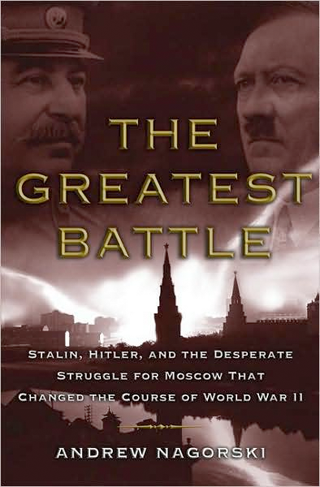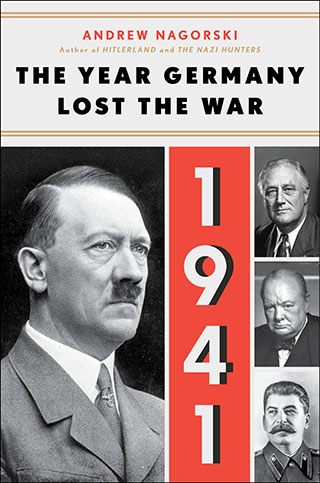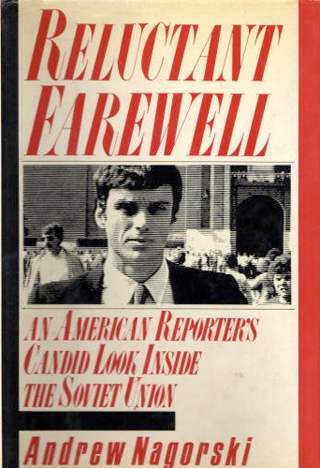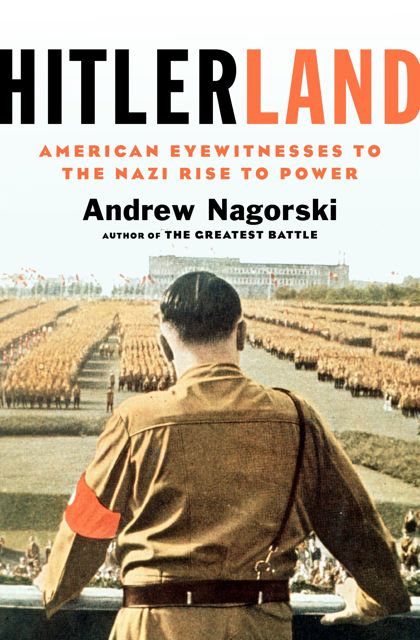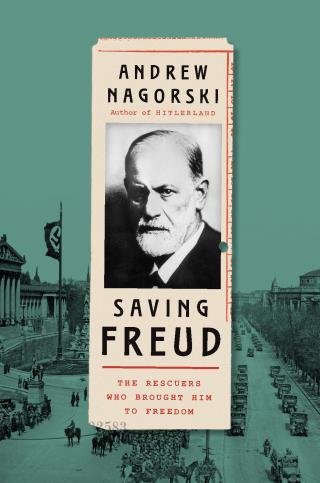by Andrew Nagorski
There is almost an irresistible temptation for many contemporary historians and journalists to churn out books and articles that unabashedly compare the rise of Adolf Hitler and his Nazi Party with the politicians and parties of today. If you think this is a phenomenon that only emerged in the Donald Trump era, think again: It started earlier.
When my book Hitlerland: American Eyewitnesses to the Nazi Rise to Power was published in 2012, I was regularly asked whether the United States was in its Weimar Republic stage, one step away from dictatorship. The queries were just as likely to come from those who viewed Republicans as the culprits leading the country down a treacherous path as from Democrats who viewed their electoral rivals in a similar light. No doubt, however, that this trend accelerated during the first Trump administration and is ramping up once again. There is always an eager audience that will applaud a new entry in the history-as-explainer-of-current-politics sweepstakes. That is, so long as that entry fits their preconceived notions.
Laurence Rees, the author of many books about the Nazis and World War II, and the former head of BBC TV History programs whose credits include the six-part documentary series Auschwitz: The Nazis and the “Final Solution,” is far too serious a historian to indulge in such facile analogies, even if doing so might boost his sales. In his latest volume, The Nazi Mind: Twelve Warnings from History, he delineates the task he set for himself—and why he zeroes in on warnings instead of lessons. “I focus on warnings because I don’t believe that history has any precise lessons,” he writes. This should not be misconstrued as a dismissal of the importance of examining the past in the context of the present. “This history matters,” he adds. “Many democracies are currently under threat and it is useful to be aware of the techniques that would-be tyrants are likely to use to subvert our freedoms.” But he insists that “this remains a history book, not a piece of political commentary” (p. 4).
While Rees has covered much of the same political, military, and social ground before, including the horrors of the Holocaust, he examines them through a somewhat different lens here. “In this book, for the first time in my work, I explore how psychology as a discipline can help us understand the mentalities of the Nazis,” he writes. But, just as with any allusions to the present, he is conscious of the limitations in applying this tool, explaining that “this is a history book informed on occasion by psychology and not a psychology book informed by history” (pp. 6–7). In other words, the author has no intention of engaging in retrospective psychoanalysis, which would be a perilous exercise for anyone, whatever their credentials.
The author presents his dozen warnings from history in chronological fashion, thus allowing him to retell the larger story of Hitler’s rise and fall while offering fresh details and insights. His first warning is about the role of conspiracy theories, with the putative explanation for Germany’s humiliating defeat in World War I serving as “exhibit A.” As Ludwig Beck, who would go on to become chief of the General Staff of the German Army under Hitler, famously put it, “We have been stabbed in the back” (p. 26).
Rees convincingly illustrates that this attempt by the country’s military leaders to deflect blame for their defeat was no spur-of-the moment decision. They carefully nurtured the notion that they could have won the war and that it was only the politicians who undercut them. Mostly shielded from reports about German defeats on the battlefield, the public was easily fooled. With the military brass scurrying for cover, the politicians had no choice but to take responsibility for the consequences. “Let them now conclude the peace that has to be negotiated,” General Erich Ludendorff told his military staff as the end neared. “Let them eat the broth they have cooked for us” (p. 25).
This conspiracy theory was a critical component of Hitler’s antisemitic message: The defeatists, those who had betrayed Germany, were either Jews or allied with Jews. They served as scapegoats for everything that went wrong during and after the Great War—and as justification for his policies right up until and including the Holocaust. All of this was predicated on blind faith in Der Führer, who was elevated to hero status while convincing his followers that it is a them [read “Jews”]-and-us [read “Aryans”] world. “His antisemitism was so outlandish that he thought the Jews controlled both capitalism and Bolshevism,” Rees notes. Psychological research, he adds, “demonstrates that such apparent inconsistencies are not uncommon among believers in conspiracies” (p. 265).
The author takes a clear position in the longstanding debate about the origins of Hitler’s fervid antisemitism. In Mein Kampf, Hitler maintained that it was a product of his early years in Vienna, before World War I, when he was already preaching his signature doctrine of hate. “But this claim, like many others he would subsequently make about his past, was false,” Rees writes. Alluding to Hitler’s failures as a painter and his impoverished existence at that time, and the lack of evidence that he was already proselytizing, Rees maintains that Hitler needed “to invent these fictions because the reality—that he had been a vacillating and inconsequential nobody—was far too devastating to reveal, especially for a leader who thought it essential to project an image of certainty and strength” (p. 37).
In his authoritative biography of Hitler, fellow British historian Ian Kershaw, whom Rees calls his close friend and mentor, takes a more nuanced view. “It seems more likely that Hitler, as he later claimed, indeed came to hate Jews during his time in Vienna,” he wrote, noting that the city was awash with antisemitism. “But, probably, at this time it was still little more than a rationalization of his personal circumstances rather than a thought-out ‘world-view.’”Footnote1
Irrespective of when Hitler arrived at his “world-view,” Rees credits his early success as a postwar rabblerouser in Munich as much to his instinctive understanding of “how the brain works” as to his oratorical skills. “By stirring up hatred against Jews and Bolsheviks he was targeting the amygdala—the part of the brain that immediately processes feelings of anxiety, fear, and anger,” he writes. As Hitler put it, “[T]he only stable emotion is hate”—and he exploited it at every opportunity (pp. 38–39).
Hitler also “instinctively” understood the reasons young people were particularly susceptible to Nazi propaganda. “While young people’s critical faculties are not yet completely developed before their mid-twenties, the parts of the brain which long for novelty and excitement are already shaped,” Rees explains. “This can lead to thrill seeking of the wildest kind” (p. 93). It is the radicals of the right and left, of course, who promise the biggest thrills. The corruption of youth is one of Rees’s most important warnings.
Another underlying theme taken up by Rees is how most of Hitler’s countrymen came to accept his most abhorrent methods. “Although against the use of violence themselves, many Germans clearly believed the violence of the Nazis might be necessary to protect them from a Communist uprising,” he writes. “In short, their longing for peace and quiet made them embrace a party that promised to use violence to achieve that aim.” Rees asserts that this is hardly a uniquely German phenomenon: “In the right circumstances most of us can be enthusiastic supporters of violence” (p. 111). Similarly, he points out that Hitler always needed enemies. “He understood that one of the easiest ways to bond people is to convince them who their enemies are. … Shrewd dictators understand that the search for enemies must be never-ending. And if you don’t have any enemies, then you need to create them” (p. 337).
Rees peppers his narrative with vivid examples of the grotesque rationalizations that Nazi leaders and many of their followers refused to jettison even after Germany’s crushing defeat and Hitler’s suicide. When they were awaiting trial at Nuremberg, some of the top Nazis claimed that they had merely stumbled into their roles. Hermann Göring told one of the American psychologists that he was on his way to join the Freemasons in 1919 but was diverted by “a pretty blonde,” which set him on a different path. Hans Frank blamed a “trick of fate” for the fact that he did not marry an early girlfriend who was opposed to the Nazis, which would have kept him away from them as well. Rees dismisses all such claims as part of an “infantile” psychological coping strategy (p. 323).
Then there were the outright lies. At Nuremberg and afterward, when he wrote his famous autobiography, Albert Speer, Hitler’s architect who also served as armaments minister, worked assiduously to convince everyone that he knew nothing about the Holocaust. Speer did not deny that he was present for Heinrich Himmler’s speech in which he openly discussed “the extermination of the Jewish people,” but he insisted that he had left the room before Himmler provided any details. This was more than disingenuous. In a letter that was only discovered after Speer’s death, Rees reports, the Nazi wrote: “There is no doubt—I was present as Himmler announced on October 6, 1943, that all Jews would be killed” (pp. 295, 299).
As devastating as such portrayals of the Nazi higher-ups are, the author’s contacts with their minions, even so long after the war, were equally depressing. Oskar Gröning, one of the last SS guards at Auschwitz to be tried and convicted, was “an unexceptional man,” Rees writes. “He was so ‘normal’ that he was rather boring to spend time with. By far the most interesting thing about him was that he had once worked at Auschwitz” (p. 332). He embodied Hannah Arendt’s concept of the banality of evil.
As Rees makes clear, evil comes in a variety of forms—and is not restricted to one place or nationality. “The truth is that the terrible crimes described in this book didn’t so much happen ‘because the Nazis were German’ as because they were human beings,” he writes (p. 325). That is his most chilling warning of all.
Notes
1 Ian Kershaw, Hitler: 1889–1936 Hubris (London, 1998), p. 67.




